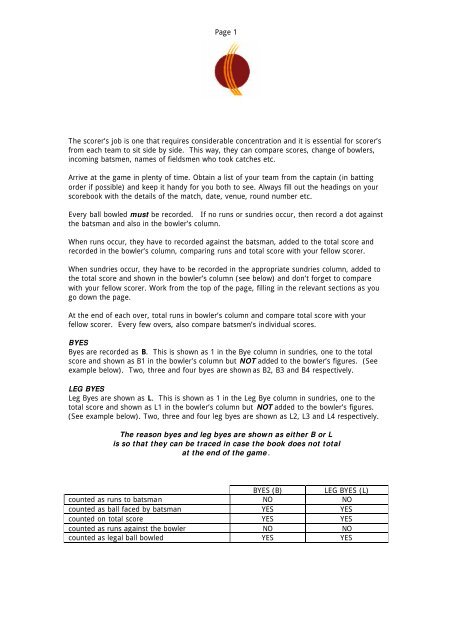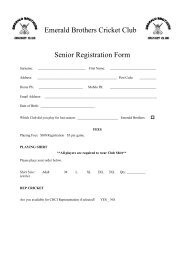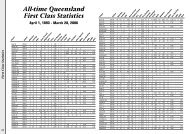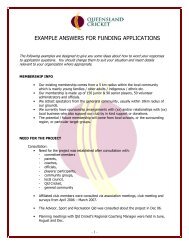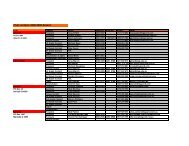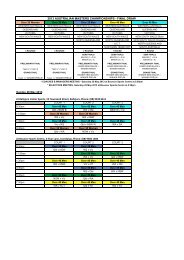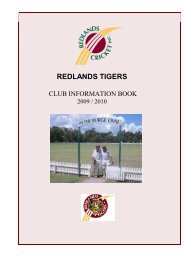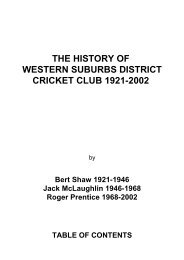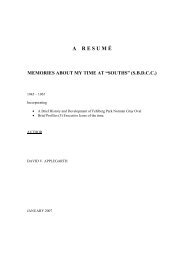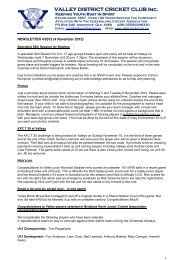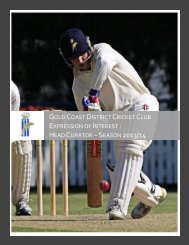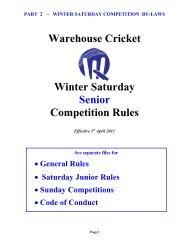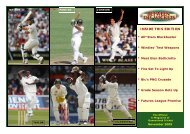Queensland Cricket Scoring Manual - Latrobe Cricket Club
Queensland Cricket Scoring Manual - Latrobe Cricket Club
Queensland Cricket Scoring Manual - Latrobe Cricket Club
You also want an ePaper? Increase the reach of your titles
YUMPU automatically turns print PDFs into web optimized ePapers that Google loves.
Page 1<br />
The scorer’s job is one that requires considerable concentration and it is essential for scorer’s<br />
from each team to sit side by side. This way, they can compare scores, change of bowlers,<br />
incoming batsmen, names of fieldsmen who took catches etc.<br />
Arrive at the game in plenty of time. Obtain a list of your team from the captain (in batting<br />
order if possible) and keep it handy for you both to see. Always fill out the headings on your<br />
scorebook with the details of the match, date, venue, round number etc.<br />
Every ball bowled must be recorded. If no runs or sundries occur, then record a dot against<br />
the batsman and also in the bowler’s column.<br />
When runs occur, they have to recorded against the batsman, added to the total score and<br />
recorded in the bowler’s column, comparing runs and total score with your fellow scorer.<br />
When sundries occur, they have to be recorded in the appropriate sundries column, added to<br />
the total score and shown in the bowler’s column (see below) and don’t forget to compare<br />
with your fellow scorer. Work from the top of the page, filling in the relevant sections as you<br />
go down the page.<br />
At the end of each over, total runs in bowler’s column and compare total score with your<br />
fellow scorer. Every few overs, also compare batsmen’s individual scores.<br />
BYES<br />
Byes are recorded as B. This is shown as 1 in the Bye column in sundries, one to the total<br />
score and shown as B1 in the bowler’s column but NOT added to the bowler’s figures. (See<br />
example below). Two, three and four byes are shown as B2, B3 and B4 respectively.<br />
LEG BYES<br />
Leg Byes are shown as L. This is shown as 1 in the Leg Bye column in sundries, one to the<br />
total score and shown as L1 in the bowler’s column but NOT added to the bowler’s figures.<br />
(See example below). Two, three and four leg byes are shown as L2, L3 and L4 respectively.<br />
The reason byes and leg byes are shown as either B or L<br />
is so that they can be traced in case the book does not total<br />
at the end of the game.<br />
BYES (B) LEG BYES (L)<br />
counted as runs to batsman NO NO<br />
counted as ball faced by batsman YES YES<br />
counted on total score YES YES<br />
counted as runs against the bowler NO NO<br />
counted as legal ball bowled YES YES
Page 3<br />
RUN OUTS<br />
When a player is run out going for his first run, no runs are recorded and he is shown as out<br />
RUN OUT. The wicket is not credited to the bowler but if no runs are recorded you could<br />
show a red R in the bowler’s analysis to denote when it happened. When a player is run out<br />
going for his second or third run, only the completed run/s are credited to the batsman,<br />
added to the total score and shown against the bowler. Therefore if a player is run out going<br />
for his third run, only the runs he has completed (in this case 2 runs have been completed)<br />
are shown against him, 2 runs added to the total score and 2 runs recorded against the<br />
bowler. You could show the R above the runs scored to denote when the run out occurred in<br />
the bowler’s analysis.<br />
DEAD BALL<br />
When a dead ball is called by the umpire and the batsmen have run, no runs are to be<br />
recorded and the batsmen will return to their respective ends. The ball is recorded as being<br />
faced by the batsman. If, however, the bowler dropped the ball before delivery and the<br />
umpire signals dead ball, nothing is recorded.<br />
FALL OF WICKETS are shown as X in the bowler’s analysis.<br />
When a wicket falls, complete time batsman was out, how batsman was out, name of bowler<br />
and how many runs batsman made. Score at fall of wicket, name of batsman out, name of<br />
batsman not out plus his score in brackets.<br />
END OF BOWLING SPELL<br />
When a bowler is taken off, a thick vertical line beside the over he last completed will indicate<br />
the end of his spell.<br />
MAIDEN OVERS<br />
When a maiden over is bowled, show a large M for that over – this makes it easier to add up<br />
number of maidens bowled.<br />
PROTECTIVE HELMETS<br />
Law 41.3<br />
If the helmet belonging to the fielding side is on the ground within the field of play and the<br />
ball, while in play, strikes it, the ball shall become dead. 5 penalty runs shall then be<br />
awarded to the batting side. Law 18.11 (b) then goes on to say that “When the ball becomes<br />
dead for any reason other than the fall of a wicket, or is called dead by an umpire, unless<br />
there is specific provision otherwise in the Laws, the batting side shall be credited with<br />
(i) all runs completed by the batsmen before the incident or call and<br />
(ii) the run in progress if the batsmen have crossed at the instant of the incident<br />
or call and<br />
(iii) any penalties that are applicable.<br />
Again, they are scored as 5 penalty runs but the batsmen are awarded the runs they have<br />
completed (or leg byes or bye runs completed) prior to the ball hitting the helmet.<br />
PENALTY RUNS – Law 42.17<br />
Five penalty runs awarded to the batting side.<br />
The Law states: “The umpire will signal by repeated tapping of one shoulder with the<br />
opposite hand.” (Remember – patting means batting). “Penalty runs are shown as penalty<br />
extras and shall be in addition to any other penalties. They shall not be regarded as runs<br />
scored from either the immediately preceding delivery or the following delivery and shall be in<br />
addition to any runs from those deliveries. The batsmen shall not change ends solely by<br />
reason of the 5 run penalty.”<br />
Explanation: The runs shall immediately be added to the total score of the batting side and<br />
should be shown as P1 in the bowler’s analysis (if it is the first occurrence of penalty runs).<br />
This is NOT added to the bowler’s total but is only to show when it occurred. Make a note in<br />
the Notes/Comments column of what the penalty is for. P2 would mean the second instance<br />
of a penalty. Check with the umpire at the first break as to why the penalty was awarded.
Page 5<br />
SIGNALS<br />
Law 4.3 - The scorers shall accept all instructions and signals given to them by the<br />
umpires. The law states that scorers shall immediately acknowledge each<br />
separate signal.<br />
It is imperative that you become familiar with umpires signals. They are as follows:<br />
Boundary Four<br />
Boundary Six<br />
Bye<br />
Leg Bye<br />
Wide ball<br />
Dead Ball<br />
No Ball<br />
Short Run<br />
Revoking a Call<br />
By waving the arm from side to side across the body.<br />
By raising both arms above the head.<br />
By raising an open hand above the head.<br />
By touching the raised knee with the hand.<br />
By extending both arms horizontally.<br />
By crossing and re-crossing both arms below the waist (no runs are<br />
scored).<br />
By extending one arm horizontally.<br />
By bending the arm upwards to touch the nearest shoulder with the<br />
tips of the fingers. One less run is put to the score (e.g. if the<br />
batsmen run 2 and short run is signalled, the batsman who struck<br />
the ball has only 1 run recorded against his name.)<br />
By crossing arms across chest. (e.g. Used when umpire has<br />
signalled a 6 then realises it was only 4 runs.)<br />
These signals should be acknowledged promptly by the scorers by waving an arm or hat<br />
above your head.<br />
Good luck with your scoring and remember to compare continually with your fellow scorer.<br />
That way, you will be able to quickly pick up and correct any errors.<br />
Judy Harris<br />
JUDY HARRIS<br />
QUEENSLAND CRICKET & CRICKET AUSTRALIA SCORER


